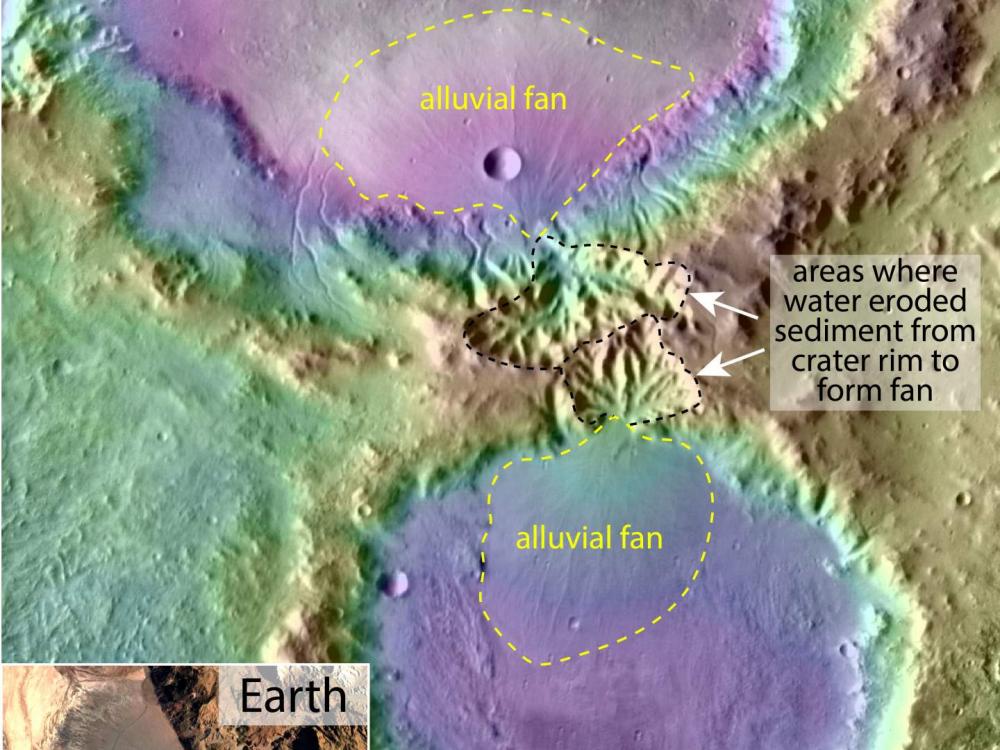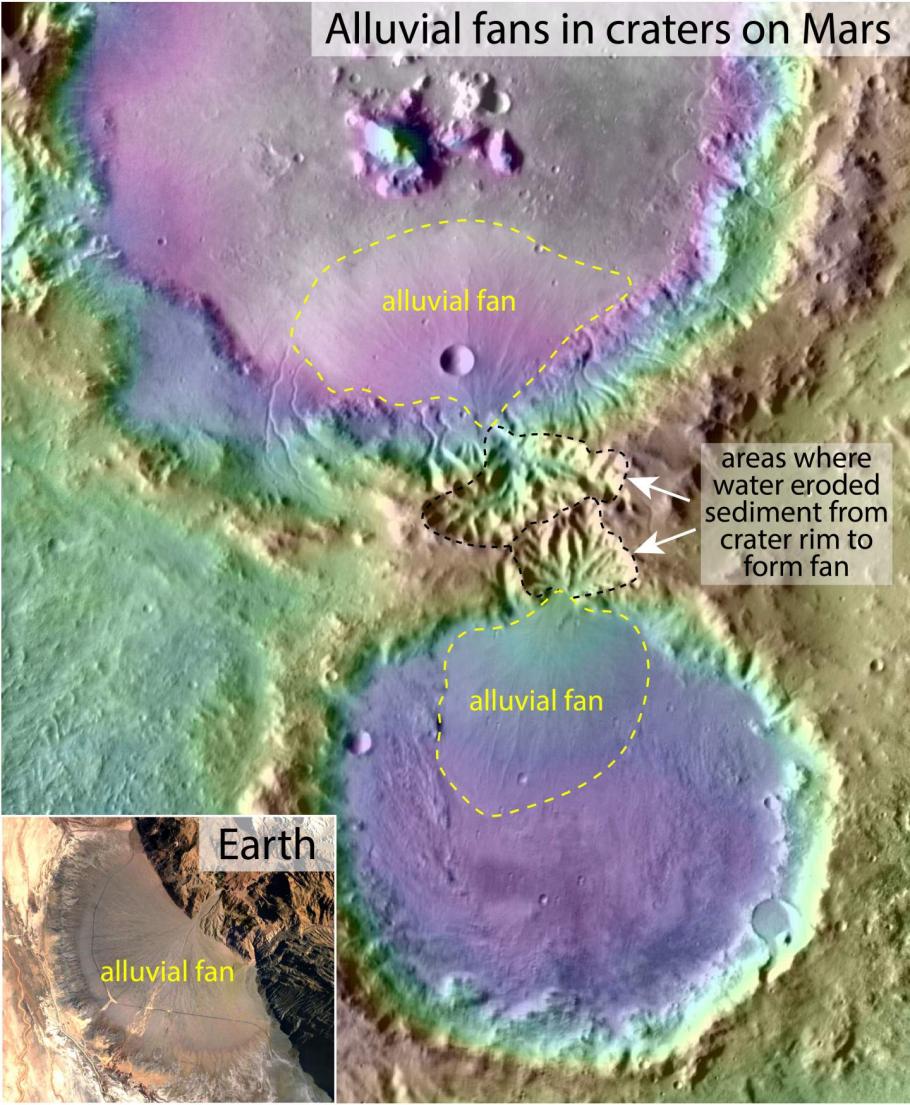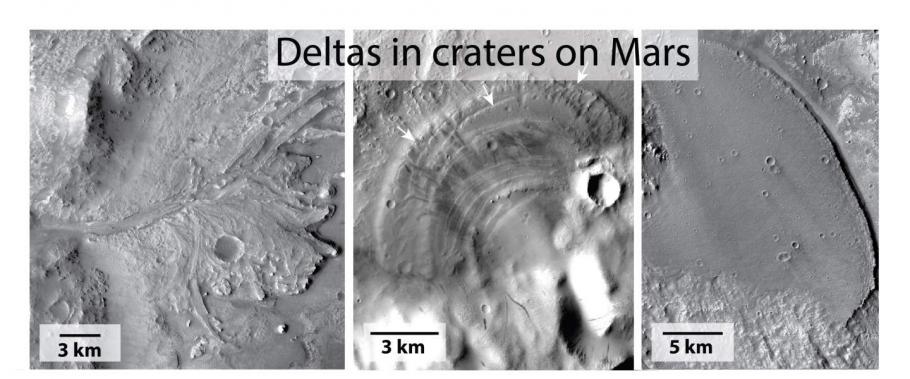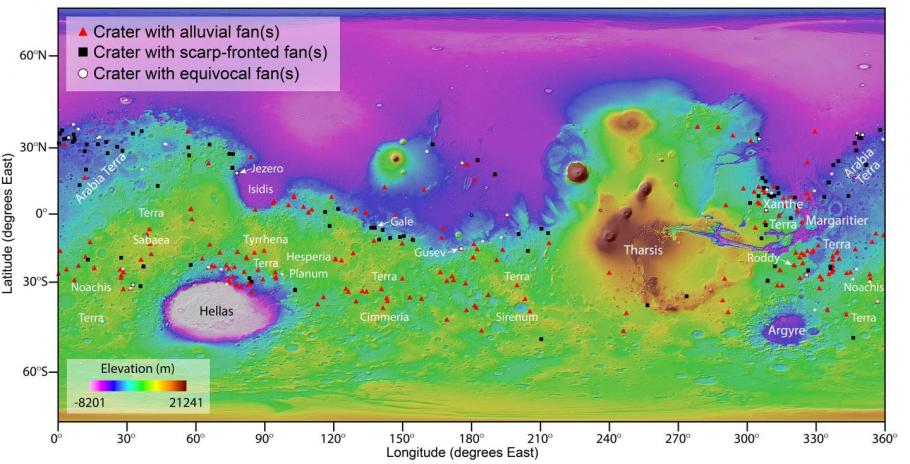
Alluvial Fans and Deltas: Windows into the Late Climate History of Mars
Feb 02, 2021
By Sharon Purdy
The conditions on Mars today are quite harsh: it is very cold, dry, and liquid water is not stable on its surface. Scientists generally believe that water was more abundant very early in Mars’ history before the atmosphere declined and the planet cooled, but the climate since then is not well understood. Scientists study deposits that were formed by water to understand what the environment was like at the time they were active. These clues can be used to decipher the evolution of the martian climate, the fate of the water, and whether the planet was favorable for the formation and preservation of life.
Alluvial fans and deltas are two types of sedimentary deposits on Mars that were formed by liquid water. Alluvial fans form when a river flows through steep mountainous terrain and deposits sediment (gravel, sand, silt) onto the adjacent, lower-lying terrain. Alluvial fans form from short-lived flow events, with sediment building up over time into cone-like deposits. On Earth, alluvial fans commonly form in tectonically active mountain fronts, such as Death Valley in California.
Alluvial fans in craters on Mars—outlined in yellow—provide important clues about the evolution of the past climate of Mars. Lower crater is ~40 miles across near 24°S, 28°E. MOLA topography—red is high, purple is low—over THEMIS. Inset, ~3 miles across, shows an alluvial fan in Death Valley, CA.
Deltas are fan-shaped deposits that form when a river flows into a standing body of water, such as a lake or ocean, like the Mississippi River delta. Deltas are of particular interest for robotic investigations because they are ideal for the preservation of organic material and microbial life. Several lake settings have been proposed as landing sites, and craters Gusev, Gale, and Jezero were ultimately selected for exploration by the Mars Exploration Rover Spirit, the Mars Science Laboratory Curiosity rover, and Mars Perseverance rover, respectively.
Deltas on Mars that formed when a river flowed into a crater that contained a lake. Jezero crater, landing site for the Perseverance rover (left), delta with terraces (middle) and the “pancake delta” in Gale crater, landing site of the Curiosity rover (right).
Numerous studies have been conducted on individual martian alluvial fan systems and deltas, but scientists did not know enough about them as a group. So, my colleagues and I set out to create a global inventory of these features to understand how common (or unique!) these fan systems and deltas are, where they occur (are they clustered together or more spread out?), and when they formed. The combination of this information tells us about the source and timing of the Martian water and if these features formed during a single event or multiple episodes of favorable climate. Building upon previous inventories, we studied images that were taken by the Context (CTX) Camera on the Mars Reconnaissance Orbiter because the resolution of the images is ideal for seeing the landforms and nearly the entire planet has been covered with this data.
Our survey identified 890 alluvial fans and 114 deltas within over 300 craters on Mars, dramatically increasing the known number of these deposits. We found that craters with deltas tend to be located at lower elevations where interactions with groundwater likely helped form lakes. The similar age and distribution of craters with alluvial fans and some of the deltas suggests there was a late occurring widespread source of precipitation (in the form of snow), rather than a local source (such as warming caused by the formation of a large impact crater). The global distribution and age of young alluvial fans and deltas is changing our understanding of how the climate on Mars evolved, and the timeframe that Mars may have been habitable for life may have lasted a few billion years longer than previously thought.
Distribution of craters with alluvial fans (red triangles), scarp-fronted fans (putative deltas) (black squares) and equivocal fans (white circles) from Wilson et al., 2021. Basemap is MOLA gridded topography over a MOLA-derived hillshade map.
Sharon Wilson Purdy recently co-authored a paper on the distribution of craters with alluvial fans and deltas on Mars.
Citation: Wilson, S. A., Morgan, A. M., Howard, A. D., & Grant, J. A. (2021). The Global Distribution of Craters with Alluvial Fans and Deltas on Mars. Geophysical Research Letters, 48, e2020GL091653. https://doi.org/10.1029/2020GL091653
Related Topics
You may also like
We rely on the generous support of donors, sponsors, members, and other benefactors to share the history and impact of aviation and spaceflight, educate the public, and inspire future generations. With your help, we can continue to preserve and safeguard the world’s most comprehensive collection of artifacts representing the great achievements of flight and space exploration.






